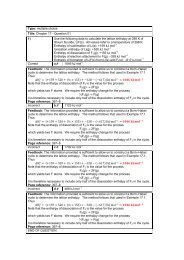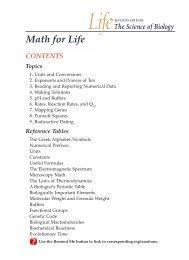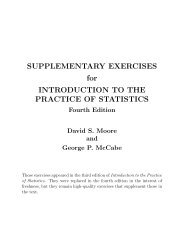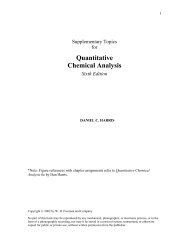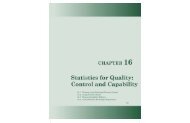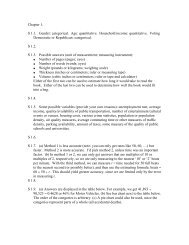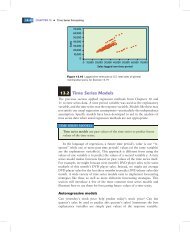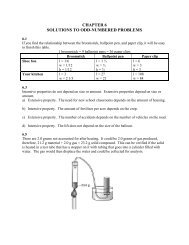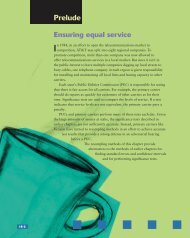Chapter 3 - Experimental Error - WH Freeman
Chapter 3 - Experimental Error - WH Freeman
Chapter 3 - Experimental Error - WH Freeman
You also want an ePaper? Increase the reach of your titles
YUMPU automatically turns print PDFs into web optimized ePapers that Google loves.
56<br />
3 <strong>Experimental</strong> <strong>Error</strong><br />
Table 3-1<br />
Summary of rules for propagation of uncertainty<br />
Function Uncertainty Function Uncertainty<br />
y x 1 x 2 e y 2e 2 x y x a<br />
1<br />
e 2 x 2<br />
%e y a %e x<br />
1 e x<br />
e x<br />
y x 1 x 2 e y 2e 2 x 1<br />
e 2 x 2<br />
y log x e y 0.434 29<br />
ln 10 x<br />
x<br />
e x<br />
y x 1 x 2 %e y 2%e 2 x 1<br />
%e 2 x 2<br />
y ln x e y <br />
x<br />
x 1<br />
e y<br />
y %e y 2%e 2 x y 10 x<br />
1<br />
%e 2 x 2<br />
(ln 10) e x 2.302 6 e<br />
x y<br />
x<br />
2<br />
e y<br />
y e x e<br />
y x<br />
NOTE: x represents a variable and a represents a constant that has no uncertainty. e x /x is the relative error in x<br />
and %e x is 100 e x /x.<br />
The natural logarithm (ln) of x is the number y, whose value is such that x e y ,<br />
where e ( 2.718 28 ...) is called the base of the natural logarithm. The absolute<br />
uncertainty in y is equal to the relative uncertainty in x.<br />
Uncertainty for<br />
natural logarithm:<br />
y ln x1 e y e x<br />
x<br />
(3-9)<br />
Now consider y antilog x, which is the same as saying y 10 x . In this case, the<br />
relative uncertainty in y is proportional to the absolute uncertainty in x.<br />
Uncertainty<br />
for 10 x :<br />
y 10 x 1 e y<br />
y (ln 10) e x 2.302 6 e x<br />
(3-10)<br />
If y e x , the relative uncertainty in y equals the absolute uncertainty in x.<br />
Uncertainty<br />
for e x :<br />
y e x 1 e y<br />
y e x<br />
(3-11)<br />
Appendix C gives a general rule for<br />
propagation of uncertainty for any<br />
function.<br />
Table 3-1 summarizes rules for propagation of uncertainty. You need not memorize the<br />
rules for exponents, logs, and antilogs, but you should be able to use them.<br />
Example<br />
Uncertainty in H Concentration<br />
Consider the function pH log[H ], where [H ] is the molarity of H . For<br />
pH 5.21 0.03, find [H ] and its uncertainty.<br />
SOLUTION First solve the equation pH log[H ] for [H ]: Whenever a b, then<br />
10 a 10 b . If pH log[H ], then log[H ] pH and 10 log[H ]<br />
10 pH . But<br />
10 log[H ]<br />
[H ]. We therefore need to find the uncertainty in the equation<br />
[H ] 10 pH 10(5.21 0.03)<br />
In Table 3-1, the relevant function is y 10 x , in which y [H ] and x (5.21 0.03).<br />
For y 10 x , the table tells us that e y /y 2.302 6 e x .<br />
e y<br />
y 2.302 6 e x (2.302 6)(0.03) 0.069 1<br />
(3-12)<br />
The relative uncertainty in y ( e y /y) is 0.069 1. Inserting the value y 10 5.21 <br />
6.17 10 6 into Equation 3-12 gives the answer:<br />
e y<br />
y <br />
e y<br />
6.17 10 0.069 11 e 6 y 4.26 10 7





